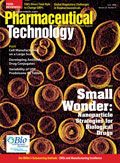Public Service Versus Self-Service
The good, the bad, and the ugly about direct-to-consumer advertising.
I was hanging out with a friend this weekend, when we got on the subject of drug advertisements on TV. My friend started imitating the way people are pictured in those ads frolicking through a beautiful garden or gamboling in a fairy-tale woodland while all of the awful side effects of the drug are being read quickly in the background. Is it any wonder, we remarked, that people don't take seriously enough the potential risks of taking any drug?

Michelle Hoffman
Interestingly, I'd had almost the exact conversation with a work colleague the week before. He was considering the issue of how to communicate risk to the public and wondering why the public gave too little heed to the potential side effects of a new drug they had available to them.
On the other hand, he pointed out, some people wouldn't even visit a doctor to inquire about a particular medical condition if those drug ads hadn't made them aware of both the condition and the fact that a potential treatment were available for it.
So which is it? Do drug ads provide a public service, or do they serve only to boost awareness of a drug product without any concomitant awareness of the risk of taking that drug?
Rooting around the Internet, I discovered that in 2002, the US Food and Drug Administration surveyed patients and physicians to determine the impact of direct-to-consumer (DTC) advertising on consumer (that is, patient) behavior. Even though the survey was performed a while ago, its findings are relevant to the discussions I've been having. Forty-three percent of patients responding to the survey were prompted to seek additional information about the drug described in the advertisement, and over 60% of those sought information about side effects from healthcare providers, pharmacists, and on the Internet.
While more than half (58%) of the patients believed the ads provided enough information for them to decide whether to discuss the drug with a healthcare provider, an even greater number felt the ads adequately stated the drug's risk. A smaller percentage (44%) of respondents thought the ads did a poor job of enumerating the drug's benefits.
Almost the same percentage of physicians (41%) felt their patients were confused about a drug's benefit because of the DTC advertisement. Approximately 40% of physicians also felt their patients did not understand the risks and possible negative effects of the drugs.
The FDA report concluded that DTC advertising was good to the degree that it motivated patients to think more about their health and to find out more about treatments available to them. They also found it "troubling" that the advertisements "overstate drug efficacy and do not present a fair balance of benefit and risk information."
In an earlier editorial, I suggested that drug makers hold off on DTC advertisements for a few years after the drug has launched until its risks are better known. It is also clear that these risks need to be enumerated more clearly and not obscured behind images of frolicking, happy people.
If that happens, it may be possible that DTC advertisements will be more public service and less self-serving.

Michelle Hoffman is editor-in-chief of Pharmaceutical Technology. Send your thoughts and story ideas to her via email at mhoffman@advanstar.com
See reader comments on this editorial.
